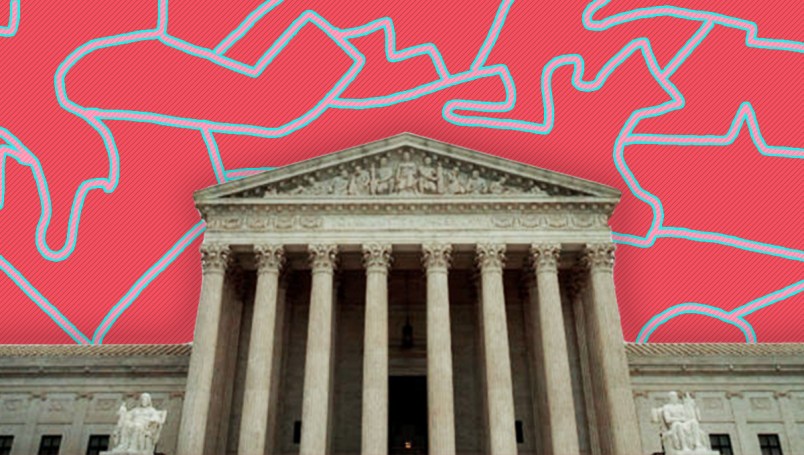The Supreme Court is slated to hear two blockbuster cases involving extreme partisan gerrymandering this spring—the last best chance for the nation’s highest court to take action on this pivotal issue before the 2020 census and once-a-decade redistricting process the following year.
With swing vote Anthony Kennedy retired from the bench and Justice Brett Kavanaugh cementing the court’s 5-4 conservative majority, there’s a legitimate fear that their ruling may not institute a fairer system.
After all, the Supreme Court has ruled that racial gerrymandering can violate the Constitution, but never before struck down a voting map as unconstitutionally gerrymandered on partisan lines. Last year, the Supreme Court kicked two related cases back to the lower courts.
But legal redistricting experts surveyed by TPM see cause for hope. The pending cases — Lamone v. Benisek out of Maryland and Rucho v. Common Cause out of North Carolina — involve such egregious, intentional partisan power grabs, committed by Democratic and Republican lawmakers, respectively, that the constitutional questions at hand are clear-cut. Experts also predict that the justices will want to impose some limits to stem the flow of cases to their docket involving this highly sensitive political issue.
“The extreme fact patterns in these cases simplify the legal issues significantly,” Thomas Wolf, an attorney with the Brennan Center specializing in redistricting, told TPM.
Both cases involve “bald, flagrant seat maximization, and that’s unconstitutional many times over,” Wolf said. “In both cases you have key movers making crystal-clear what their intent was in their own words.”
Dan Vicuña, national redistricting director for Common Cause, said that the facts in his organization’s case against North Carolina “are about as egregious as the court will ever see.”
“If that doesn’t offend the Constitution, I don’t know what does,” Vicuña told TPM. “So we feel good about where things stand. I think we’ll put together a strong amicus campaign that will have a lot of bipartisan academics, current and former elected officials, folks who can make a strong case that this is clearly a constitutional problem—to allow elected officials to manipulate districts.”
In the North Carolina case, a three-judge panel of a federal district court found that GOP lawmakers intentionally drew districts to protect their members and hurt Democratic opponents. Under this map, Republicans managed to hold on to 10 of the state’s 13 congressional seats in the 2018 midterms, even though Democrats won over 50 percent of the vote.
This was no accident, by the GOP’s own admission. As Rep. David Lewis (R) put it: “I think electing Republicans is better than electing Democrats. So I drew this map to help foster what I think is better for the country.”
The Maryland case, which the Supreme Court declined to decide last June on procedural grounds, involves an overzealous Democratic gerrymander. Republican voters alleged that Democratic state lawmakers intentionally and successfully drew a map in 2011 that would oust a longtime Republican incumbent, giving Democrats a 7-1 advantage in congressional seats. Former Gov. Martin O’Malley acknowledged that he hoped to create “a district where the people would be more likely to elect a Democrat.”
In both cases, there are stark statements of intent by the architects of the plan. The plaintiffs also have strong standing to bring them. Common Cause’s Vicuña said they intentionally built their case to avoid standing issues after the Supreme Court ruled last year that Wisconsin Democratic voters failed to prove that a GOP-orchestrated redistricting plan caused them personal harm.
“That was something we anticipated, and that was the reason why we brought on the state Democratic Party as well as individual plaintiffs from every district,” he said.
Lawyers representing plaintiffs in both cases acknowledge that the departure of Kennedy makes their job more difficult. Kavanaugh’s vote is uncertain, as his tenure on the D.C. Circuit Court did not involve any gerrymandering cases.
“It’s a bit more of a cloudy crystal ball right now,” Michael Kimberly, an attorney at Mayer Brown who represents the plaintiffs in the Maryland case, told TPM.
But Kimberly said he feels “cautious optimism” about his prospects. For one thing, the court slightly accelerated the scheduling of the Maryland case so that oral arguments in both cases would be held on the same day in March.
“I do think it’s a good thing to have a broader array of legal theories before the court,” Kimberly said. “The more options that we put in front of the justices, and the more opportunity that they have to compare and contrast them, the more likely it is that they’ll land on a good answer.”
Paul Smith of the Campaign Legal Center, which is representing other plaintiffs in the North Carolina case, agreed that the scheduling maneuvering was an “optimistic sign.”
Moving up the schedule allows the justices additional time to write their opinions, Smith said, suggesting, to him, “that there is at least some interest in doing something substantive here rather than just batting their hand at us.”
Legal experts noted there are some self-interested reasons for the Supreme Court to institute rules to stop the most extreme examples of gerrymandering. All these pending redistricting cases are burdening their caseload, and Chief Justice John Roberts is keen to maintain the court’s perceived independence in this hyper-partisan political moment.
“We have the Chief Justice in a very different posture in the Kavanaugh world, where he’s looking for ways to make the court look less partisan and trying to show that the court is a court of law, not a court of politics,” the Campaign Legal Center’s Smith said.
Jeff Wice, a redistricting expert at the SUNY Rockefeller Institute of Government, agreed that Roberts doesn’t want to “see the Supreme Court as a parking lot for every political case that parties want to bring” and is keen to “balance the court’s caseload.”
As Wice pointed out, there are still more than a dozen states fighting in court over plans enacted after the last round of redistricting in 2011—an “unprecedented” figure.
If the court doesn’t take some action before the 2020 census sets the terms for the next map-drawing cycle in 2021, “There could be no end to this.”
The Supreme Court has never delineated clear standards for what constitutes an impermissibly partisan gerrymander, but intent is key. They have defined the practice as “the drawing of legislative district lines to subordinate adherents of one political party and entrench a rival party in power”—a standard that presumably applies to congressional maps as well.
Some legal scholars have argued that the Supreme Court can rely on scientific standards developed to determine examples of gerrymandering—comparing the share of the popular vote to the share of congressional seats, for example. Using these scientific measures to account for partisan asymmetry in how districts are drawn would allow the court to try to satisfy individual voters’ right to equal treatment under the 14th Amendment.
Even a formula that only applies to the most extreme examples of partisan gerrymandering would represent a huge step forward for a court that has taken no action on this issue, the Brennan Center’s Wolf said.
“The court doesn’t need to step in and solve everything that’s wrong with our redistricting processes,” Wolf said. “If it comes in and knocks out the limit cases, we will have made substantial advances.”
Despite the causes for optimism, there is no guarantee that the court will do so. A ruling that the Constitution imposes no limits on the practice is possible, and worth losing sleep over, as some experts and good-government groups are cautioning. Rick Hasen, an election law professor at the University of California Irvine who runs the Election Law Blog, laid out the nightmare scenario in an Atlantic piece this week, anticipating that the court will reverse lower courts rulings finding the Maryland and North Carolina cases unconstitutional.
If that happens, experts predict, legislatures will have free rein to engage in extreme partisan gerrymandering come 2021.
Just look at North Carolina, where the GOP’s gerrymander-protected supermajority control of the legislature empowered them to pass jurisdiction-stripping statutes and attempt to reduce the governor’s authority. Or Pennsylvania, where Republican lawmakers threatened to impeach state Supreme Court justices who stepped in to declare their congressional map an unconstitutional gerrymander.
“We’re not just talking about threats to voter rights,” Wolf said. “We’re talking about threats to the structure of our democracy.”










